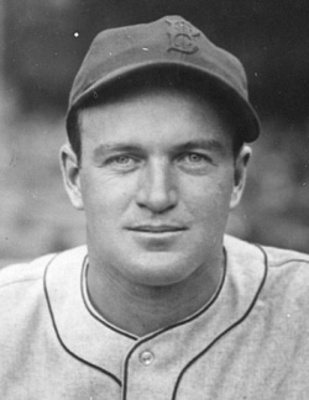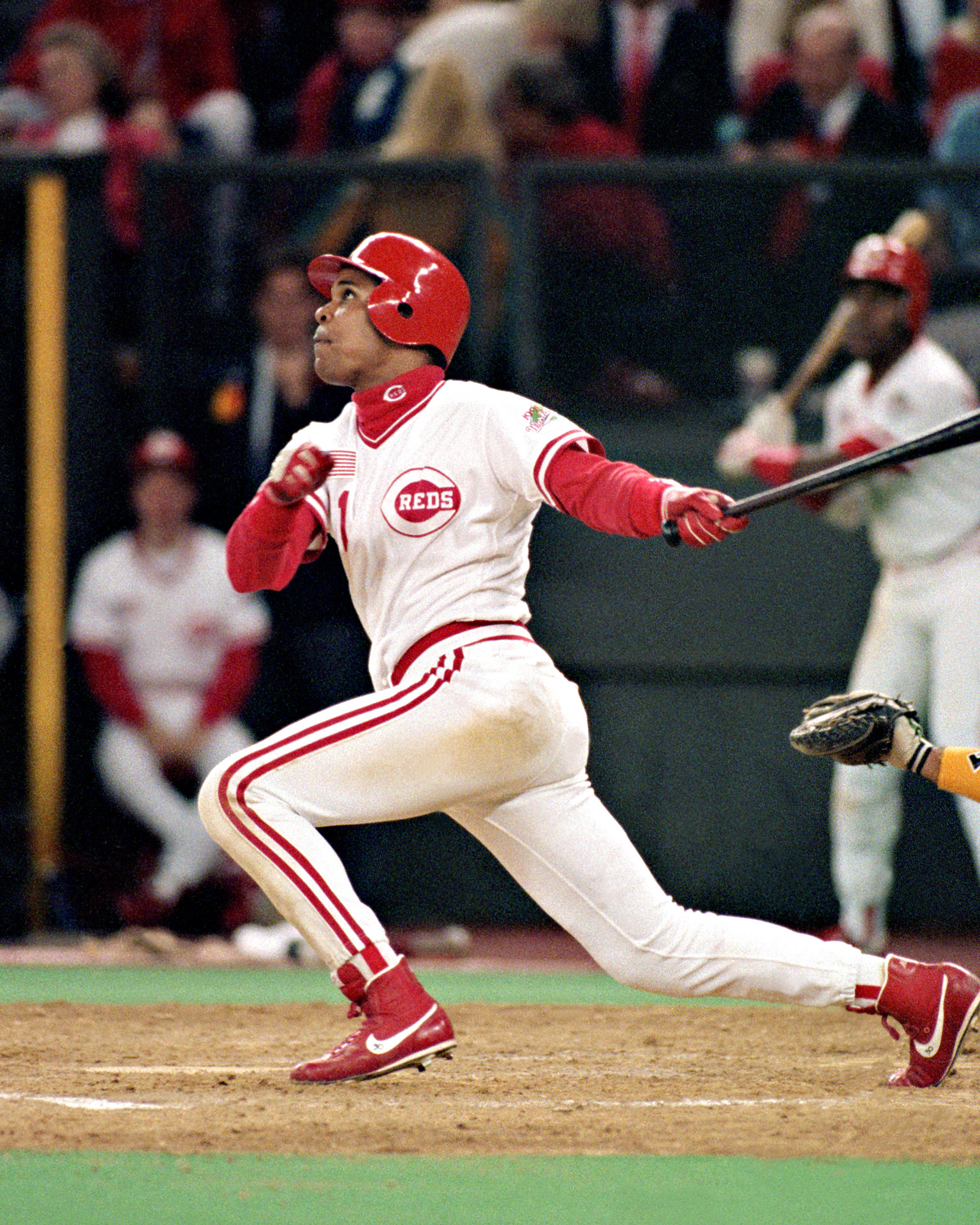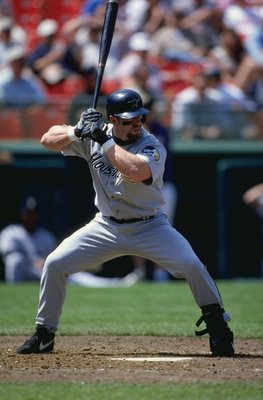The game started off poorly for Hubbell. It looked like he would be more of a pawn than a king in this game. Charlie Gehringer led off the game with a single to center and took second when Hubbell's teammate, Wally Berger made an error. Hubbell then walked Heinie Manush and there were two on with no one out and three of the greatest hitters the game has ever known coming up in a row. Each one by themself would be enough to give a pitcher a heart attack. All three of them in a row would be the stuff of nightmares.
First was Babe Ruth. He had already hit 699 career Home Runs, including 13 so far this year and had hit one in the last game before the break (he also had a double and drove in 4 lifting his season average to .300 to end the first half). He certainly was not threatening to hit 60 Home Runs this year but there was still lethal power in that bat and with two men on base Ruth was sure he could make an impact on the game. Suddenly Hubbell's screwball started to work. He almost completely abandoned the fastball and curve. "The thing to do was, you might just show them those pitches but don't get anythng over the plate with the screwball." Hubbell said. Hubbell threw five screwballs and Ruth struck out swinging. As he walked back to the bench Lou Gehrig walked to the plate. The two teammates were not exactly on speaking terms personally but this was professional and Ruth probably muttered something about watching out for that damn screwball catching the front corner of the plate.
Gehrig was at the top of his game and was definitely one of the most feared hitters in baseball. Gehrig was on fire this year. He came into the All Star Break with 21 doubles, 24 Home Runs, was hitting .367 and had driven in an almost unheard of 91 RBI just half way through the season. If Ruth terrified a pitcher Gehrig would make most pitchers want to curl up in a ball and cry. At least doing that would avoid the pain that was seemingly inevitable because if you don't throw the ball he can't hit it out of the park. But Hubbell had to make a pitch at some point. "Gehrig, if I can keep that ball down, keep those breaking balls down I can get him to hit the ball on the ground there's a chance for a double play and I can get out of the inning." Gehrig ruined his plans. Hubbell worked Gehrig and gained the advantage. He had the best hitter of the year off balance and Gehrig went down swinging. Manush and Gehringer pulled off a double steal moving the runners to second and third. Hubbell didn't care. The runners were meaningless right now. Two outs and still two men on base. Not just two outs but two straight strikeouts of two straight Hall of Fame players.
Gehrig shook his head and headed back to the dugoout. On the way back to the bench he passed the beast. Jimmie Foxx, the big "Double X". Gehrig may have told the two time reigning MVP in the absolute prime of one the greatest careers in history, swing away because if you catch hold of one it will go a long way. In the days before weight training was an accepted part of the training for a baseball player Foxx's arms were gigantic. They didn't make uniforms big enough for arms the size of sequoias so Foxx cut the sleeves. He carried his 44 ounce bat up to the plate and was ready to take a few cuts at Hubbell's screwball. Foxx swung away and tried to send one to the deepest parts of the Polo Grounds. Instead, he let loose a cut that would have made the mighty Casey proud but hit only the air. Strike three. And three first ballot Hall of Fame players went down on strikes. It was an amazing thing and it was only partly done.
In the bottom of the first the National League got off to a fast start. Frankie Frisch, the Fordham Flash and manager of the St.Louis Cardinals, led off the game with a Home Run to right field. The next three batters went in order and Hubbell took the slow walk back out to the mound with a 1-0 lead.
This was his park. This was his crowd. This was his home. This was his mound. He owned this place and he owned these batters.
Al Simmons stepped in, took a few practice cuts and prepared to swing away. He was swinging a hot bat at .348 for the year with 58 RBI on the year but he had been stuck on 13 Home Runs for a week. He faced off against Hubbell and followed the example of Ruth, Gehrig and Foxx before him. He walked back to the dugout after swinging through strike three.
Up next was Joe Cronin. The "boy wonder" manager of the Washington Senators. The sporting world thought Senators owner Clark Griffith was nuts when he decided to give Cronin the manager job at the start of the 1933 season but Cronin and Griffith laughed all the way to an American League pennant. It would be the last trip to the postseason for Washington baseball until 2012. Cronin was having a slightly off year so far, he came into the break hitting only .289, but he was still dangerous. Hubbell took care of him with ease. His fifth straight strike out of a fifth straight Hall of Fame member.
The All Star Game was designed to display the best against the best to see who would create the most magical memories. Hubbell created the first truly special All Star Game moment, one that is still considered among the great achievements in baseball history. Hubbell's streak of strike outs would be broken when Bill Dickey, the Yankees catcher, hit a single in the at bat folllowing Cronin. King Carl ended the second inning by striking out Lefty Gomez.
Hubbell pitched a total of three innings and faced 13 batters (all of them future Hall of Fame members) and struck out six of them. He left the game with a 1-0 lead although Dodgers Pitcher Van Lingle Mungo would blow the save and take the loss in the game. Leave it to a Dodger to ruin a Giant's big moment.
Nothing like this would happen again in an All Star Game for another 66 years. The 1999 All Star Game was a celebration of the All Century Team and it took place at historic Fenway Park. The pregame ceremony was one of the great moments in All Star history. One by one legends poured onto the field: Stan Musial, Hank Aaron, Willie Mays, Frank Robinson and Ted Williams mingled with Tony Gwynn, Ken Griffey Jr and Cal Ripken. The biggest moment of the night came when the game started. Pedro Martinez, like Hubbell in 1934, pitching in front of his home crowd started the game by striking out Barry Larkin (future Hall of Fame member), Larry Walker (fighting for a batting title), and Sammy Sosa (in the middle of another 60 Home Run season).
His American League teammates scored twice in the first with RBI singles by Jim Thome and Cal Ripken and Pedro walked back out to the mound to face the most feared hitter in the game, Mark McGwire. Like the last three, McGwire went down on strikes. Four in a row. One more and he would tie Hubbell's record.
At the plate was Matt Williams. He didn't give Martinez a chance to strike him out. He grounded the first pitch to Roberto Alomar at second base and when Alomar couldn't handle it Williams was safe on an error. Jeff Bagwell battled for six pitches and as Bagwell swung through the final pitch Williams was thrown out trying to steal for a double play.
Hubbell had struck out five straight Hall of Fame members in a row. Martinez had struck out 5 of 6 batters at the prime of their careers. There is a debate of which was more impressive. Undoubtedly, Hubbell's was more impressive for several reasons:
1. The 1934 All Star Game was taken very seriously. In recent years it has evolved into a friendly exhibition but there were still very deep seated hard feelings between the leagues in 1934. When Hubbell accomplished his feat the batters were not up there swinging for the fences to launch a tape measure Home Run. These batters were trying to win a game.
2. A strike out now is accepted and almost expected of a big power hitter, whereas, at the time of Hubbell's accomplishment a strikeout was much less acceptable. In the entire 1934 season Ruth would strike out 63 times, Gehrig only 31, Foxx 75, Al Simmons 58 and Cronin 28. By comparison, in the complete 1999 season Larkin would strike out 57 times, Walker 52 times (these two are comparable to Cronin, Gehrig, Ruth and Simmons), Sosa 171 times, McGwire 141 times and Bagwell 127 times.
3. Bagwell struck out but he swung at a pitch he never would have normally considered swinging at. With Williams on base the hit and run was put on. When Williams, not a strong base stealer, took off for second Bagwell had to try to make contact no matter what. If he didn't Williams would be hung out to dry for sure. Bagwell swung through a pitch well outside the strike zone that he desperately was trying to foul off.
4. The overall format of the league was different in 1934. There was still a lot of animosity between the leagues (the baseball wars had only ended about 30 years before and wounds were still fresh. Because of the animosity between the leagues it was less common (though not unheard of) to have trades between American and National League teams. This was long before free agency so players were not choosing what team they wanted to sign with every few years and it was before interleague play so the only chance anyone from one league had to face someone from the other league was in the World Series. Hubbell had never faced most of these batters before (he had faced Cronin the year before in the World Series) so Hubbell had to learn what they liked to hit quickly. Martinez had been in the National League for several years before moving on to Boston. He had faced these batters in his National League seasons and also faced some of them in Interleague Play on an almost yearly basis. Martinez knew these hitters and knew what they liked and where they liked it making Hubbell's feat even more amazing.
Clearly based on these statistics and the over all philosophical approach to the game at the time of Hubbell's accomplishment, his is the better of the two.
TRIVIA QUESTION:
Of the five players struck out by Pedro Martinez in the 1999 All Star Game there was a combined total of four MVP's (Barry Larkin (1995), Larry Walker (1997), Sammy Sosa (1998), Mark McGwire (none) and Jeff Bagwell (1994) among them. Of the five players struck out by Carl Hubbell (Lou Gehrig, Babe Ruth, Jimmie Foxx, Al Simmons and Joe Cronin) how many combined MVP's were there in the group?
LAST WEEK'S ANSWER:
The innaugural class of Hall of Fame inductees were elected in 1936 and comprised six members:
Honus Wagner (SS)
Babe Ruth (OF)
Christy Mathewson (P)
Walter Johnson (P)
Ty Cobb (OF)
No player has ever received a 100% vote for the Hall of Fame (shockingly there were apparently some writers who felt these five were not Hall of Fame players). Ruth and Wagner appeared on identical 95.1% of the ballots. Christy Mathewson appeared on 90.7, Johnson 83.6 and Cobb 98.2. There has been a tradition among sports writers that because none of these all time greats received a 100% vote, no player will ever receive 100%. Because of this tradition players like DiMaggio, Mays, Jackie Robinson, Tony Gwynn (and any other player you can name who would define a Hall of Fame player) did not receive a 100% vote on the Hall of Fame ballot.
LAST WEEK'S ANSWER:
The innaugural class of Hall of Fame inductees were elected in 1936 and comprised six members:
Honus Wagner (SS)
Babe Ruth (OF)
Christy Mathewson (P)
Walter Johnson (P)
Ty Cobb (OF)
No player has ever received a 100% vote for the Hall of Fame (shockingly there were apparently some writers who felt these five were not Hall of Fame players). Ruth and Wagner appeared on identical 95.1% of the ballots. Christy Mathewson appeared on 90.7, Johnson 83.6 and Cobb 98.2. There has been a tradition among sports writers that because none of these all time greats received a 100% vote, no player will ever receive 100%. Because of this tradition players like DiMaggio, Mays, Jackie Robinson, Tony Gwynn (and any other player you can name who would define a Hall of Fame player) did not receive a 100% vote on the Hall of Fame ballot.








first off: why dont we hear the name heine more often? my next question... why were babe ruth and lou gehrig not on good terms as u mentioned in the post?
ReplyDeletejth
You're right. We don't hear the name Heinie anymore. Actually there were several players named Heinie in the early parts of the 1900's. In addition to Manush there was also Heinie Groh for the Reds and Giants (he was featured in the "Players You May Not Know but Should" series) and Heinie Zimmerman of the Cubs and Giants (he was banned aong with Hal Chase after the Black Sox scandal). Overall there have been 22 players named Heinie appearing in the Majors over the years but none since Heinie Heltzel. Heltzel was born in York, PA and appeared in 29 games for the 1943 Boston Braves and 11 games for the 1944 Phillies.
DeleteRuth and Gehrig did not get along for many reasons. Mostly they were just two different people. Ruth was flamboyant and loved the spot light. Gehrig was business like and didn't care about getting noticed. He just wanted to play and win. There were several incidents including salary negotiations and off the fild family clashes. They were able to reconcile before Gehrig's death. Some of the disagreements seem more like friendly bickerings than open warfare but they definitely had periods where they were no on speaking terms.
i agree that Hubbell's all star game was more impressive than Martinez's. Hubbell faced better batters. On the other hand, when a batter has never faced a pitcher, it is usually advantage to the pitcher.
ReplyDeleteMy guess for the trivia question is 5. I don't think Al Simmons won an MVP.
TJD